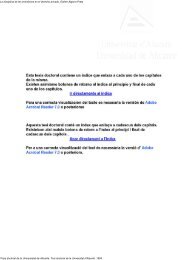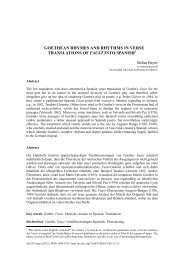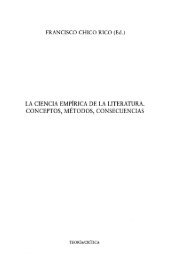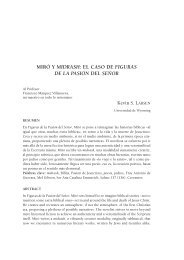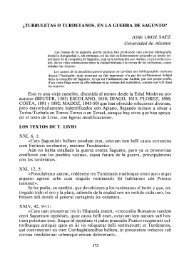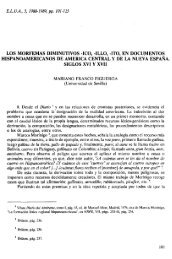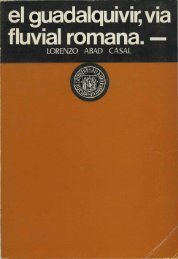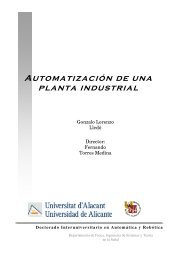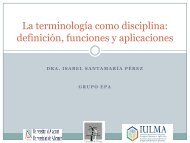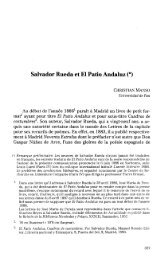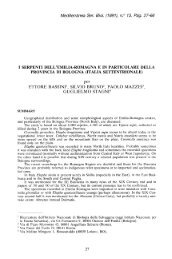ecological effects of marine protected areas empafish project ...
ecological effects of marine protected areas empafish project ...
ecological effects of marine protected areas empafish project ...
Create successful ePaper yourself
Turn your PDF publications into a flip-book with our unique Google optimized e-Paper software.
EMPAFISH Booklet no. 1 Ecological <strong>effects</strong> <strong>of</strong> Atlanto-Mediterranean MPAs in the EU<br />
Contacts<br />
Francisca Miota - Biologist<br />
reservasmarinas@mapya.es<br />
Centro de Información de la Reserva Marina, Explanada del Muelle,<br />
s/n<br />
- 38915 La restinga (El Hierro), Canary Islands<br />
Tel : +34 922 55 71 88 / Fax : + 34 922 55 71 87<br />
www.mapa.es/rmarinas/<br />
La Restinga: <strong>ecological</strong> studies<br />
� General<br />
o Fish assemblage<br />
The first quantitative studies <strong>of</strong> the inshore fish community in the area were<br />
conducted in 1989 and 1994 by the American foundation “Earthwatch” in<br />
collaboration with the University <strong>of</strong> La Laguna. They used underwater visual<br />
census (UVC) data to describe the basic structural parameters (species<br />
richness, abundance, diversity, etc.) (Bortone et al. 1991). Subsequently,<br />
Bortone et al. (1992) compared the number, size and biomass <strong>of</strong> parrotfish<br />
(Sparisoma cretense) between the islands <strong>of</strong> El Hierro and Fuerteventura.<br />
After the creation <strong>of</strong> the MPA in 1996, several monitoring studies were<br />
performed with irregular periodicity (Brito et al. 1998, 2001b, 2005a).<br />
Recently, other studies partially conducted in the MPA have been published<br />
(Tuya et al. 2004, 2006). In addition, some studies have highlighted the<br />
increase <strong>of</strong> the tropical fish fauna in the Canary archipelago (Brito et al. 1995,<br />
2001a, 2005b), probably related to the changes <strong>of</strong> the environmental<br />
conditions. In view <strong>of</strong> the fact that the RMCMR is located in the side with the<br />
warmest waters <strong>of</strong> the archipelago, most <strong>of</strong> these tropical species have<br />
appeared in this area, many <strong>of</strong> them sporadically, but some <strong>of</strong> them<br />
(Gnatholepis thompsoni, Canthidermis sufflamen, Caranx crysos and,<br />
probably, Mulloides martinicus) have stable populations at the moment.<br />
o Benthic communities<br />
A preliminary mapping <strong>of</strong> the benthic bionomy was made by Barquín et al.<br />
(1997). A more complete mapping and characterization <strong>of</strong> benthic biocoenosis<br />
<strong>of</strong>f El Hierro, including the <strong>marine</strong> reserve, is presently being updated. Also,<br />
within some <strong>of</strong> the <strong>project</strong>s financed by the Regional Government in order to<br />
study the reserve effect since the implementation <strong>of</strong> the MPA (Brito et al.<br />
1998, 2001b, 2005a), density and size structure <strong>of</strong> the main commercial<br />
invertebrates, such as limpets (Patella spp.) and <strong>marine</strong> snails (Osilinus<br />
atratus), have been studied. Some <strong>ecological</strong> studies <strong>of</strong> the long-spined sea<br />
urchin Diadema antillarum have been recently initiated, but just a few<br />
preliminary results have been published for the moment (Hernández et al.<br />
2005a, 2005b). Finally, some studies have been partially conducted in the<br />
GINLMR (Tuya et al. 2004; Navarro et al. 2005; Tuya & Haroun, 2006).<br />
89



